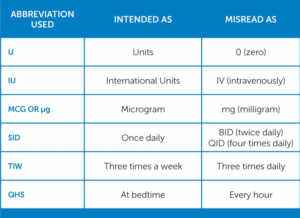What does MCG (ug) mean on a label?
When looking at supplements, it is always important to read and follow the label. This is especially true for measurements and dosing.
Supplements are sometimes confusing and with certain vitamins, the dose is sometimes given as “International Units” or IU, and others may refer to “Micrograms” or mcg”, or “µg”. There is no universal unit of measurement around the world, and each health authority deciding their own recommended daily dose. In the future, both ways of dosing are likely going to be shown on the packaging. [6]
In most European countries micrograms (µg) are considered the preferred unit of measurements.
What does microgram mean?
A microgram is a physical unit of measurement, measured at one-millionth of a gram or one-thousandth of a milligram[1] and is a part of the Popular Reference Intake (PRI), otherwise known as the Recommended Daily Allowance (RDA).
Why are there different symbols?
The symbol for microgram, µg, comes from the Greeks – where µ means “small”. Together, (µ) translates to “small”, and (g) commonly represents gram. Small gram. Microgram! While µg is the proper symbol, it is not available on a traditional keyboard. This is why it appears as micrograms displayed as “ug”, “mcg”, or “µg” on labels.[2]
Microgram vs Milligram
Pay attention to abbreviations to prevent one unit of measurement from being mistaken for a different unit of measurement. The abbreviation “mcg” and “µg” (for micrograms) can be mistaken for “mg” (for milligrams), creating a 1000-fold overdose.[3]
Converting between Micrograms and International Units
A simple approach to converting measurements is the following vitamin D conversion table:
| Micrograms (mcg) | How to Calculate | International Units (UI) |
| 10 mcg | Multiply by 40 | 400 IU |
| 15 mcg | Multiply by 40 | 600 IU |
| 20 mcg | Multiply by 40 | 800 IU |
| 25 mcg | Multiply by 40 | 1000 IU |
| 50 mcg | Multiply by 40 | 2000 IU |
| 100 mcg | Multiply by 40 | 4000 IU |
Other related misinterpretations
 Chart adapted from U.S. Department of Health and Human Services [4]
Chart adapted from U.S. Department of Health and Human Services [4]
It is important to always refer to the Nutritional Information and Directions provided by the product (typically located on the side of the packaging) and to speak to your health care professional before taking any new medications. For those living in the UK, Thinkmist DHA is available.
If you would like to look more into the differences between milligrams, micrograms, and international units for vitamins, the National Institute of Health’s Office of Dietary Supplements is a good resource to explore.[5]
This post was originally published on August 1, 2017.
- [2] https://www.justvitamins.co.uk/blog/what-does-ug-mean/#.WV5XqMYZPBI
- [2] https://www.justvitamins.co.uk/blog/what-does-ug-mean/#.WV5XqMYZPBI
- [3] https://www.fda.gov/animalveterinary/resourcesforyou/ucm214772.htm
- [4] https://www.fda.gov/animalveterinary/resourcesforyou/ucm214772.htm
- [5] https://dietarysupplementdatabase.usda.nih.gov/ingredient_calculator/help.php#q10
- [6] Container label changes for vitamin A, D, and E. Institute for safe medical practices. 2018 https://www.ismp.org/resources/container-label-changes-vitamin-d-and-e


